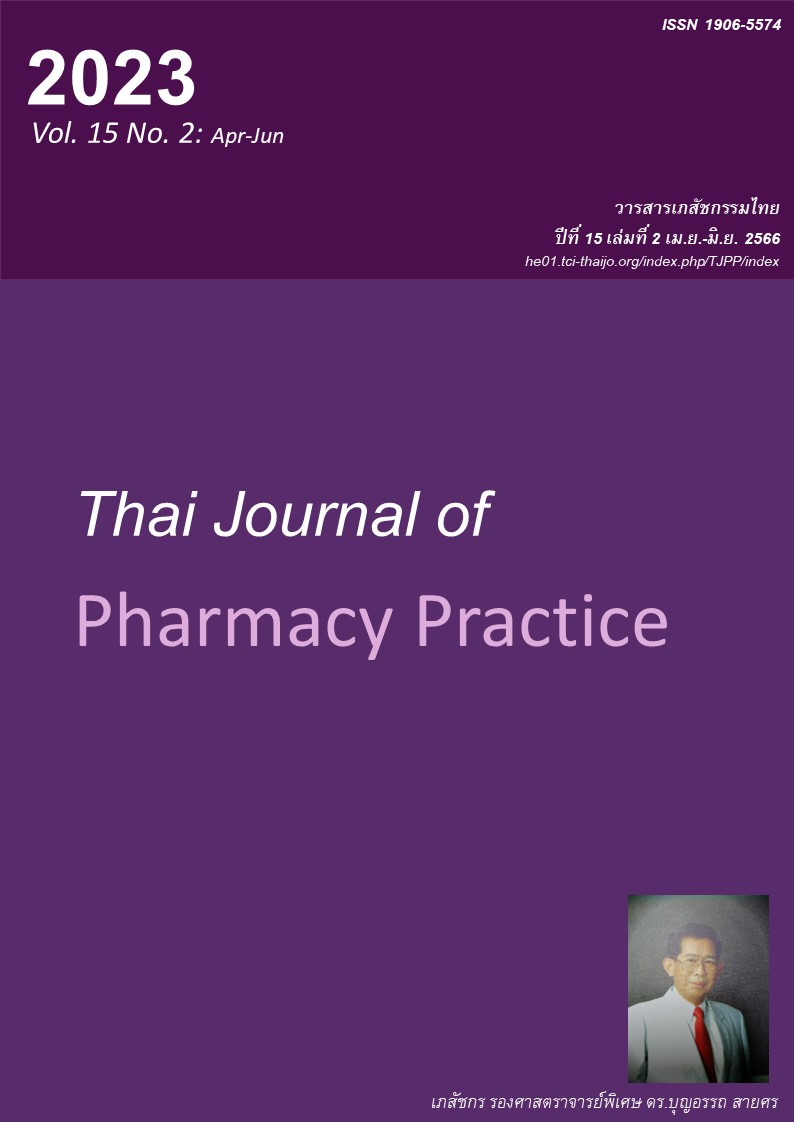การพัฒนาเครื่องมือเก็บสารคัดหลั่งจากโพรงจมูก
Main Article Content
บทคัดย่อ
วัตถุประสงค์: เพื่อพัฒนาอุปกรณ์สำหรับเก็บสารคัดหลั่งจากโพรงจมูกและทดสอบประสิทธิภาพของเครื่องมือในห้องปฏิบัติการ วิธีการ: การวิจัยและพัฒนานี้ได้สร้างเครื่องมือต้นแบบสำหรับการรวบรวมสารคัดหลั่งจากโพรงจมูกผ่านการระดมสมองของผู้มีส่วนได้ส่วนเสีย และการออกแบบและการผลิตเครื่องมือ ต่อจากนั้น ต้นแบบได้รับการทดสอบในห้องปฏิบัติการเพื่อประเมินประสิทธิภาพและความปลอดภัยโดยใช้หุ่นจำลอง ผลการวิจัย: เครื่องมือที่พัฒนาขึ้นนี้เหมาะสำหรับการรวบรวมสารคัดหลั่งจากช่องจมูก เนื่องจากทำให้เข้าถึงช่องจมูกได้ ทำให้เห็นได้ชัดเจนถึงตำแหน่งที่ควรเก็บตัวอย่าง และใช้การดูดด้วยแรงดันต่ำแทนการดูดซับในการเก็บตัวอย่าง เครื่องมือนี้ได้รับการทดสอบ 1,000 ครั้ง และพบว่าสามารถเข้าถึงบริเวณช่องจมูกโดยไม่ต้องสัมผัสเนื้อเยื่อรอบข้าง เครื่องมือมีดัชนีประสิทธิภาพร้อยละ 96.09 โดยไม่มีหลักฐานว่า อุปกรณ์เจาะทะลุไปยังบริเวณโดยรอบ สรุป: ผลการทดสอบในห้องปฏิบัติการของต้นแบบที่พัฒนาขึ้นนั้นมีแนวโน้มดี ดังนั้น สามารถนำต้นแบบไปทดสอบเพิ่มเติมในเรื่องประสิทธิภาพและความปลอดภัย
Article Details

อนุญาตภายใต้เงื่อนไข Creative Commons Attribution-NonCommercial-NoDerivatives 4.0 International License.
ผลการวิจัยและความคิดเห็นที่ปรากฏในบทความถือเป็นความคิดเห็นและอยู่ในความรับผิดชอบของผู้นิพนธ์ มิใช่ความเห็นหรือความรับผิดชอบของกองบรรณาธิการ หรือคณะเภสัชศาสตร์ มหาวิทยาลัยสงขลานครินทร์ ทั้งนี้ไม่รวมความผิดพลาดอันเกิดจากการพิมพ์ บทความที่ได้รับการเผยแพร่โดยวารสารเภสัชกรรมไทยถือเป็นสิทธิ์ของวารสารฯ
เอกสารอ้างอิง
Harr KE. Sample collection. Vet Clin North Am Exot Anim Pract. 2018;21:579-92.
Massey CJ, Diaz Del Valle F, Abuzeid WM, Levy JM, Mueller S, et al. Sample collection for laboratory-based study of the nasal airway and sinuses: a research compendium. Int Forum Allergy Rhinol. 2020;10(3):303-13.
Marty FM, Chen K, Verrill KA. How to obtain a nasopharyngeal swab specimen. N Engl J Med. 2020;382:e76.
Piras A, Rizzo D, Longoni E, Turra N, Urru S, Saba PP, et al. Nasopharyngeal swab collection in the suspicion of Covid-19. Am J Otolaryngol. 2020;41:102551.
Mawaddah A, Gendeh HS, Lum SG, Marina MB. Upper respiratory tract sampling in COVID-19. Malays J Pathol. 2020;42:23-35.
Zitek T. The Appropriate use of testing for COVID-19. West J Emerg Med. 2020;21:470-2.
Cheng MP, Papenburg J, Desjardins M, Kanjilal S, Quach C, Libman M, et al. Diagnostic testing for severe acute respiratory syndrome-related coronavirus 2: A narrative review. Ann Intern Med. 2020;172:726-34.
da Silva SJR, Silva CTAD, Guarines KM, Mendes RPG, Pardee K, Kohl A, et al. Clinical and laboratory diagnosis of SARS-CoV-2, the virus causing COVID-19. ACS Infect Dis. 2020;6:2319-36.
Chaimayo C, Kaewnaphan B, Tanlieng N, Athipanyasilp N, Sirijatuphat R, Chayakulkeeree M, et al. Rapid SARS-CoV-2 antigen detection assay in comparison with real-time RT-PCR assay for laboratory diagnosis of COVID-19 in Thailand. Virol J. 2020;17:177.
Mak GC, Cheng PK, Lau SS, Wong KK, Lau CS, Lam ET, et al. Evaluation of rapid antigen test for detection of SARS-CoV-2 virus. J Clin Virol. 2020;129:104500.
Department of Medical Sciences, Ministry of Public Health. Self-test antigen test kit (ATK) for the public. [cited 2021 Nov 3]. Available from: https://www3.dmsc.moph.go.th/post-view/1243
List of COVID-19 rapid test antigen or antigen test kits (COVID-19 antigen test self-test kits) that are permitted to be manufactured/imported from the food and drug administration. [cited 2021 Nov 3]. Available from: https://www.fda.moph.go.th/sites/Medical/Shared%20Documents/%E0%B8%82%E0%B9%89%E0%B8%AD%E0%B8%A1%E0%B8%B9%E0%B8%A5%E0%B8%A3%E0%B8%B2%E0%B8%A2%E0%B8%8A%E0%B8%B7%E0%B9%88%E0%B8%AD%E0%B8%8A%E0%B8%B8%E0%B8%94%E0%B8%95%E0%B8%A3%E0%B8%A7%E0%B8%88%E0%B9%81%E0%B8%A5%E0%B8%B0%E0%B8%99%E0%B9%89%E0%B8%B3%E0%B8%A2%E0%B8%B2%20COVID-19%20Home%20use.pdf
Yamayoshi S, Sakai-Tagawa Y, Koga M, Akasaka O, Nakachi I, Koh H, et al. Comparison of rapid antigen tests for COVID-19. Viruses. 2020;12:1420.
Zhen W, Smith E, Manji R, Schron D, Berry GJ. Clinical evaluation of three sample-to-answer platforms for detection of SARS-CoV-2. J Clin Microbiol. 2020;58:e00783-20.
Procop GW, Shrestha NK, Vogel S, Van Sickle K, Harrington S, Rhoads DD, et al. A direct comparison of enhanced saliva to nasopharyngeal swab for the detection of SARS-CoV-2 in symptomatic patients. J Clin Microbiol. 2020;58:e01946-20.
Klein JAF, Krüger LJ, Tobian F, Gaeddert M, Lainati F, Schnitzler P, et al. Study Team. Head-to-head performance comparison of self-collected nasal versus professional-collected nasopharyngeal swab for a WHO-listed SARS-CoV-2 antigen-detecting rapid diagnostic test. Med Microbiol Immunol. 2021;210:181-6.
Dinnes J, Deeks JJ, Adriano A, Berhane S, Davenport C, Dittrich S, et al. Cochrane COVID-19 diagnostic test accuracy group. Rapid, point-of-care antigen and molecular-based tests for diagnosis of SARS-CoV-2 infection. Cochrane Database Syst Rev. 2020;8:CD013705.
Dinnes J, Deeks JJ, Berhane S, Taylor M, Adriano A, Davenport C, et al. Cochrane COVID-19 diagnostic test accuracy group. Rapid, point-of-care antigen and molecular-based tests for diagnosis of SARS-CoV-2 infection. Cochrane Database Syst Rev. 2021;3:CD013705.
Zawolkow G. The Internet of Things and keeping samples safe. MLO Med Lab Obs. 2015;47:45.
Singh RP, Javaid M, Haleem A, Suman R. Internet of things (IoT) applications to fight against COVID-19 pandemic. Diabetes Metab Syndr. 2020;14:521-4.


